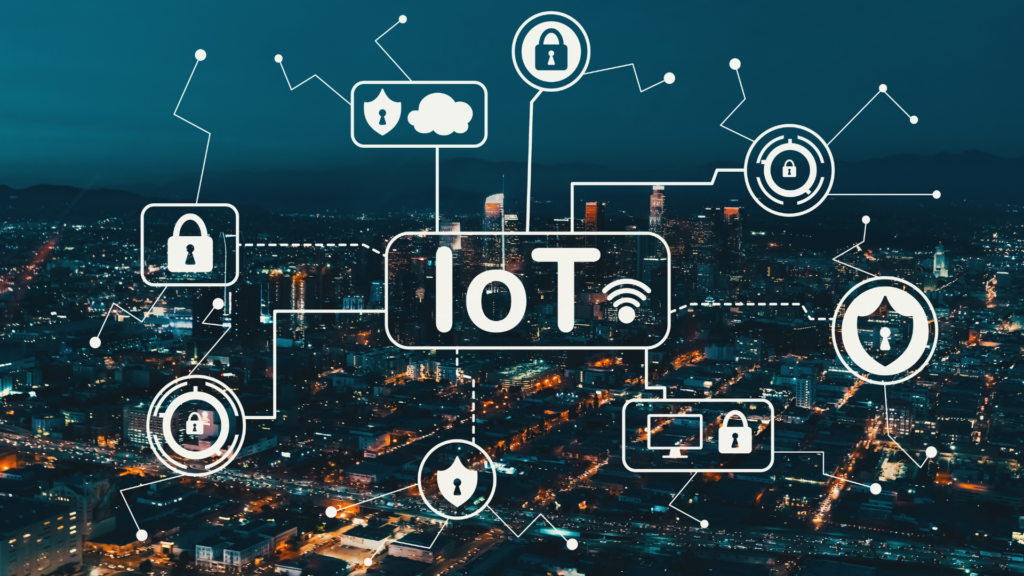The Internet of Things (IoT) has transformed the way we interact with the world around us. From smart homes and wearable devices to industrial machinery and healthcare systems, IoT has become an integral part of our daily lives.
In this article, we will explore the meaning and explanation of IoT, its applications, benefits, challenges, and real-world examples.
Whether you’re a technology enthusiast or someone curious about the potential of IoT, this article will provide you with a comprehensive understanding of this groundbreaking concept. Let’s jump into it!

What is the Internet of Things?
The Internet of Things, or IoT, is an interconnected ecosystem of devices and systems that are connected to the internet and can communicate with each other.
These devices, commonly referred to as IoT devices, range from everyday objects such as smartphones and smart home appliances to industrial machinery and vehicles.
They are equipped with sensors, actuators, and software, which allow them to collect data, process it, and perform various tasks.
How Does IoT Work?
IoT devices work by collecting data through their embedded sensors and sending it to an IoT platform or system for further processing. The sensors can gather information such as temperature, humidity, motion, light, and much more. This data is then transmitted to the IoT platform through wired or wireless communication protocols, such as Wi-Fi, Bluetooth, or cellular networks. The IoT platform processes the data, applies analytics and machine learning algorithms to derive meaningful insights, and triggers appropriate actions or alerts.
IoT Applications
The applications of IoT are vast and diverse, with significant implications across various industries and sectors. In the consumer space, IoT devices have become increasingly popular, ranging from smart thermostats and wearables to voice-activated assistants and home security systems. These devices enhance convenience, efficiency, and comfort for individuals in their daily lives.
In the industrial realm, IoT is commonly referred to as Industrial IoT (IIoT) or Industry 4.0. It involves the use of IoT technologies and systems in manufacturing, logistics, energy management, and other industrial processes. IIoT enables real-time monitoring, predictive maintenance, and optimization of operations, leading to improved productivity, cost savings, and enhanced safety.
Benefits of IoT

The adoption of IoT brings numerous benefits to individuals, businesses, and society as a whole. Some key advantages include:
Enhanced Decision-Making
IoT provides valuable data insights that enable informed decision-making, predictive analytics, and the identification of trends and patterns that were previously inaccessible.
Improved Efficiency
IoT devices automate various tasks, monitor performance in real-time, and optimize processes, leading to increased operational efficiency and reduced resource wastage.
Cost Savings
IoT devices can optimize energy consumption, reduce maintenance costs through predictive maintenance, and streamline operations, resulting in significant cost savings for businesses and individuals.
Improved Safety and Security
IoT systems can be employed for surveillance, asset tracking, and real-time monitoring, enhancing safety and security in homes, workplaces, and public spaces.
New Business Opportunities
The proliferation of IoT opens up new avenues for innovative products, services, and business models. Companies can leverage IoT data to gain a competitive edge and create personalized customer experiences.
Enhanced Customer Experience
IoT enables personalized and customized experiences for customers. By gathering data and insights about customer preferences, behaviors, and usage patterns, organizations can deliver personalized services and products. IoT-enabled devices also provide convenience, automation, and seamless integration for customers, improving overall satisfaction.
Remote Monitoring and Control
IoT allows remote monitoring and control of devices and systems. Organizations can remotely access and manage IoT devices, enabling efficient monitoring, maintenance, and troubleshooting. Remote control capabilities are particularly beneficial in scenarios where physical access is limited or costly.
Sustainability and Environmental Benefits
IoT contributes to sustainability efforts by optimizing resource usage, reducing waste, and minimizing environmental impact. Smart energy management systems, for example, enable precise monitoring and control of energy consumption. IoT can also help optimize logistics and transportation, reducing fuel consumption and emissions.
Improved Quality of Life
IoT devices enhance daily life by offering convenience, comfort, and improved health monitoring. Smart home devices automate household tasks, provide energy efficiency, and enable remote control. IoT-enabled healthcare devices allow remote patient monitoring, personalized care, and early detection of health issues.
Data-Driven Insights and Innovation
IoT generates vast amounts of data that can be analyzed to uncover trends, patterns, and correlations. These insights drive innovation, process optimization, and the development of new products and services. Organizations can gain a competitive advantage by leveraging IoT data to create personalized experiences and deliver innovative solutions.
IoT Technologies and Standards
IoT encompasses a wide range of technologies that enable its functioning. These include sensors, actuators, connectivity protocols, cloud computing, edge computing, and machine learning algorithms.
Standards and protocols such as Internet Protocol (IP) and MQTT (Message Queuing Telemetry Transport) facilitate communication between IoT devices and platforms, ensuring interoperability and seamless integration.
IoT Device Management
With the increasing number of connected devices, effective management of IoT devices becomes crucial.
IoT device management involves activities such as device provisioning, configuration, monitoring, and software updates. It ensures the security, reliability, and optimal performance of IoT devices throughout their lifecycle.
Enterprise IoT
Enterprise IoT refers to the deployment of IoT solutions within businesses and organizations to improve operational efficiency, enable data-driven decision-making, and enhance overall productivity. It involves the integration of IoT devices, platforms, and services tailored to specific enterprise needs.
IoT adoption in the enterprise sector has gained momentum due to its potential to transform various industries. For example, in manufacturing, IoT sensors embedded in machinery can monitor performance, detect anomalies, and trigger maintenance activities, minimizing downtime and optimizing production. In logistics and supply chain management, IoT-enabled tracking devices provide real-time visibility of shipments, enabling efficient inventory management and timely delivery.
The benefits of enterprise IoT are far-reaching. It allows companies to collect vast amounts of data from various sources, analyze it to gain valuable insights, and make data-driven decisions. This data-driven approach helps in optimizing operations, predicting demand, and improving overall business efficiency. Moreover, IoT enables the automation of routine tasks, reducing manual labor, and freeing up employees to focus on higher-value activities.
Additionally, enterprise IoT plays a crucial role in the integration of the physical and digital worlds. By connecting devices, systems, and processes, it facilitates seamless data flow and communication across different departments and functions. This integration leads to improved collaboration, streamlined workflows, and enhanced coordination among stakeholders.
IoT, Machine learning, and AI Integration
The integration of IoT and artificial intelligence (AI) is a powerful combination that amplifies the capabilities of both technologies.
Machine learning and AI algorithms can process and analyze the vast amount of data generated by IoT devices, extracting valuable insights and patterns. Machine learning algorithms, a subset of AI, can identify trends, anomalies, and correlations in the data, enabling predictive analytics and proactive decision-making.
For example, in a smart manufacturing environment, AI algorithms can analyze real-time data from IoT sensors to identify patterns that indicate potential equipment failures. This enables proactive maintenance, minimizing downtime and maximizing productivity.
Similarly, in retail, AI-powered analytics can process IoT-generated data to personalize customer experiences, optimize inventory management, and deliver targeted marketing campaigns.
Need help for the integration of IoT devices? Need a machine learning process to analyze data? iterates can help you with that.
Challenges and Issues with IoT
While the Internet of Things offers plenty of opportunities, it also presents significant challenges and concerns that need to be addressed:
- Security: The interconnected nature of IoT devices raises security concerns. Weak security measures can make devices vulnerable to hacking, data breaches, and unauthorized access. Robust security protocols, encryption, and regular software updates are essential to mitigate these risks.
- Privacy: IoT devices collect and transmit a vast amount of personal and sensitive data. Ensuring data privacy and implementing strict data governance policies are crucial to protect individuals’ privacy rights and comply with regulations.
- Scalability and Interoperability: As the number of IoT devices grows, scalability becomes a challenge. Interoperability issues arise when devices from different manufacturers use different communication protocols, hindering seamless integration and data sharing.
- Data Management: Handling the enormous volume of data generated by IoT devices requires effective data management strategies. This involves data storage, processing, analysis, and ensuring data quality and integrity.
- Ethical Considerations: IoT raises ethical questions related to data usage, consent, and potential misuse. Clear guidelines and ethical frameworks are necessary to address these concerns and ensure responsible IoT deployments.
To understand better what is Internet of things, you can also watch this video 👇
Examples of IoT devices
- Smart Home Devices: Devices that enable automation and control of various aspects of the home environment.
Here are some examples: smart thermostats (e.g., Nest), smart lighting systems (e.g., Philips Hue), smart security cameras (e.g., Ring), and voice-activated assistants (e.g., Amazon Echo).
- Wearable Devices: These devices are worn by individuals to track and monitor health and fitness metrics.
Examples include fitness trackers (e.g., Fitbit), smartwatches (e.g., Apple Watch), and medical devices like glucose monitors and heart rate monitors.
- Industrial Sensors: IoT sensors used in industrial settings to monitor and optimize processes.
A few examples are: temperature sensors, pressure sensors, humidity sensors, and vibration sensors used in manufacturing, oil and gas, and logistics industries.
- Industrial Machinery: Industrial IoT devices used for predictive maintenance and optimization of equipment.
To illustrate: sensors embedded in manufacturing machinery, industrial robots, and connected drones used for inspection and monitoring.
- Smart Appliances: Household appliances that are connected to the internet for enhanced functionality and convenience.
Examples include smart refrigerators, smart ovens, smart washing machines, and smart TVs.
- Smart City Infrastructure: IoT devices used in urban environments for efficient management and sustainability.
Notable examples include: smart streetlights that adjust brightness based on real-time conditions, waste management systems with smart bins, and parking systems that provide real-time availability information.
- Healthcare Monitoring Devices: IoT devices used in healthcare settings for remote patient monitoring, medication management, and personalized care.
Examples include smart insulin pumps, wearable ECG monitors, and smart pill dispensers.
- Agricultural IoT Devices: IoT devices used in agriculture to monitor and optimize farming processes.
For instance: soil moisture sensors, weather stations, livestock tracking devices, and automated irrigation systems.
Conclusion
The Internet of Things has revolutionized the way we interact with the physical world, offering immense possibilities across various domains.
From smart homes and consumer devices to industrial applications and enterprise solutions, IoT is transforming industries, improving efficiency, and driving innovation.
However, it also comes with its own set of challenges, including security, privacy, scalability, and ethical considerations. Addressing these challenges is crucial for realizing the full potential of IoT and ensuring a safe and sustainable IoT ecosystem. With ongoing advancements and continued investments, the Internet of Things is poised to reshape industries, enhance our lives, and pave the way for a connected future.
If you want to learn more about the IT world, we have articles on this subject, like 4 ways to reduce the cost of developing a mobile application.
